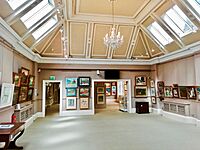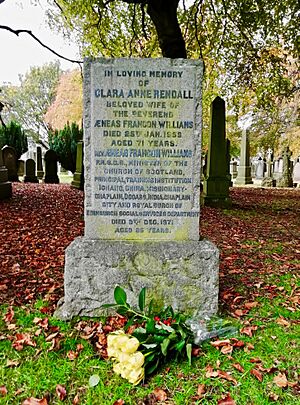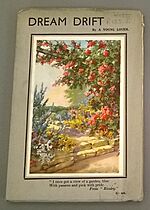Aeneas Francon Williams facts for kids
Quick facts for kids
Aeneas Francon Williams
|
|
|---|---|
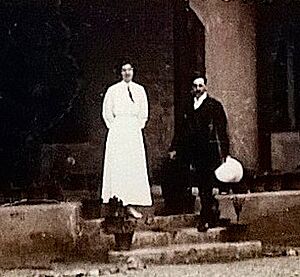
Williams (right, holding a hat) standing on the steps of Wolseley House, Kalimpong 1914
|
|
| Born | 17 February 1886 |
| Died | 9 December 1971 (aged 85) |
| Nationality | British |
| Occupation | Missionary, Minister, Chaplain, teacher, writer, poet |
| Spouse(s) | Clara Anne Rendall |
| Children | 2 |
| Parent(s) | John Francon Williams Barbara Balmain Dougall |
Aeneas Francon Williams (born February 17, 1886 – died December 9, 1971) was a British minister for the Church of Scotland. He was also a Missionary, Chaplain, writer, and poet. Williams spent many years working as a missionary in the Eastern Himalayas and China. He wrote many books and poems during his life.
Contents
Aeneas Williams' Early Life and Family
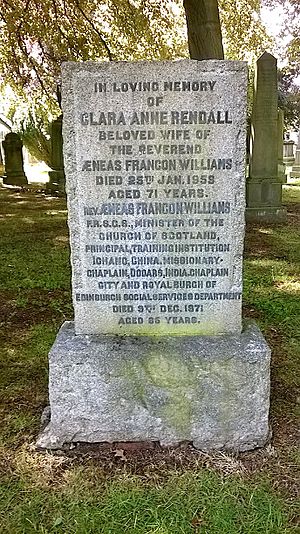
Aeneas Francon Williams was born in Liscard, Wirral, England. He was the second of four sons born to John Francon Williams and Barbara Balmain Dougall. Aeneas had three brothers and one sister.
He was educated privately during his younger years. Later, he studied at the Technical Institute in Walthamstow. He also attended the University of Edinburgh and Moray House Training College. In 1932, he returned to Edinburgh to study for two more years.
Aeneas's father, John Francon Williams, was a writer, newspaper editor, and geographer. His mother, Barbara, was from Scotland. By 1901, Aeneas and his family lived in Chingford, Essex. At 15, Aeneas was listed as an artist and painter.
Aeneas Williams' Missionary Work
Aeneas Williams dedicated a large part of his life to missionary work. This involved helping people and spreading Christian teachings in different parts of the world.
Working in Kalimpong, India
When Aeneas was 24, he attended a big meeting called the 1910 World Missionary Conference in Edinburgh. This conference was important for starting the modern Christian movement to work together. At this meeting, Aeneas felt called to become a missionary.
Later that year, Aeneas went to India. He worked at St Andrew's Colonial Home in Kalimpong, West Bengal. This was an orphanage and school. Aeneas started as an assistant schoolmaster, teaching Math, Geography, and Science. As the school grew, he also became the Bursar, managing its finances. He lived in Wolseley House on the school grounds.
Aeneas quickly settled into his new life. He also helped Dr. John Anderson Graham, the founder of the home, with finances and fundraising. Kalimpong was a very important center for missionary work in that area.
On December 2, 1914, Aeneas married Clara Anne Rendall in Kalimpong. Clara was also a Church of Scotland missionary. She taught French at St. Andrew's Colonial school. Aeneas and Clara had twins, Alfred and Beatrice, in 1916. The family stayed at St Andrew's Colonial Home until 1924.
Mount Everest Expedition Visit
In 1922, St Andrew's Colonial Home hosted the first Mount Everest expedition. This was the first time climbers tried to reach the top of Mount Everest. Famous climbers like George Mallory were part of the team.
The climbers arrived by train and then walked to St Andrew's Colonial Home. They stayed there for three days to relax. Everyone at the school was very excited. There were football games, golf, and evening sing-alongs. Aeneas, Clara, and their children helped welcome the climbers. Wolseley House, where Aeneas lived, provided temporary rooms for the lead mountaineers.
After their stay, the expedition continued their journey to Mount Everest. They set a new world record for climbing height. However, they did not reach the summit that year.
Aeneas Williams' Books on Weather and Surveying
In 1923, Aeneas Williams published his book, Everyone's Book of the Weather. He wrote this book while working at St Andrew's Colonial Home in Kalimpong. He wanted to help more people understand weather. He explained that knowing about weather is useful and interesting, especially with new technologies like wireless reports and air travel.
Two years later, he published another book called Surveying for Everyone. This book was also for students.
Working in Yichang, China

In February 1924, Aeneas, Clara, and their seven-year-old twins traveled to China. They sailed up the Yangtze River to Yichang. Aeneas became the Principal at the Anglo-Chinese College Mission in Yichang from 1924 to 1927. Their children, Alfred and Beatrice, went to a private boarding school called Redcroft School.
Aeneas and Clara learned to speak Mandarin fluently. Yichang was an important trading port in central China. During his time in China, Aeneas wrote a poem called Voice of an Oracle (in Old China).
Leaving China for Safety
By late 1926, there was growing unrest in China. The Church of Scotland advised Aeneas to leave for his safety. Clara and the children left China first and sailed to the UK.
In early 1927, Chiang Kai-shek, a leader of the National Revolutionary Army, met with Aeneas Williams in Yichang. Aeneas helped arrange for Chiang Kai-shek's troops to use the mission's facilities as they passed through. Chiang Kai-shek later became the ruler of China.
Aeneas left China in April 1927, just before a major event called the Shanghai massacre. He traveled to British Columbia and then to Vancouver for missionary work. He then sailed back to England and reunited with his family in Edinburgh, Scotland.
In October 1927, Aeneas gave a speech in Kirkcaldy, Scotland, about his missionary work in Kalimpong and Yichang. He shared exciting stories about his adventures and the people he helped.
Working in Mahakalguri, India
In late 1927, Aeneas and Clara returned to India. They were stationed in Mahakalguri, where Aeneas became a missionary Pastor. Their children, Alfred and Beatrice, stayed in Edinburgh to continue their schooling. They lived at Home House, a special home for children of missionaries.

In 1928, Aeneas and Clara were appointed as visitors to a local jail in Jalpaiguri. Their role was to help prisoners and ensure their well-being. Aeneas was also ordained as a minister in North Bengal that year.
Working in Matelli, India
In 1929, Aeneas moved to the Church of Scotland Guild Mission in Matelli, West Bengal. He became the Minister of the Jalpaiguri Parish. He and Clara lived at the Manse (the minister's house) on the mission grounds. The Church of Scotland Mission provided Christian education from kindergarten to university level through its schools.
In 1930, Aeneas Francon Williams published Hymn Book in Jalpaiguri Mech. This was a hymn book for Christians of the Mech Tribes living near the Himalayas. It was the first hymn book published in this local dialect of Hindi. While in Matelli, Aeneas also owned a Cinchona plantation, which is where quinine comes from.
Clara also continued her work as a non-official visitor for jails in the Jalpaiguri district. She helped to improve the lives of inmates and prepare them for release.
In 1932, Aeneas visited Scotland and gave speeches about his important work in India. He shared stories about helping people in the Eastern Duars region. In 1934, his son Alfred started studying medicine at the University of Edinburgh.
In 1937, Aeneas and Clara, along with their grown children Alfred and Beatrice, traveled to New York City.
Aeneas Williams' Poetry
Williams' first book of poems, Dream Drift, by a Young Lover, was published in 1938. He dedicated the book to his wife, Clara. Reviewers noted that his poems showed his love for nature, sports, and life.
There are conductors pale who stand
tiptoe before the band
and all the instrumentalists are dumb
until the white-hot baton
and the thumb of the magician
makes cryptic potion
And with the motion
there comes the strange effusion
of dreamy cadence
like incense smoke
that winds and sways
all ways
Aeneas found inspiration in everyday life. For example, his poem To A Dead Bird was inspired by a small bird he found near his home in Bengal. He gave it a small burial service.
You lay so limp and weightless in my hand
that I could scarce believe you were of earth
and not an airy being having birth
in some aloof, imponderable land
I knew the fervour of your evening song
and felt the rapture of your vibrances
the lilting pleasure of new cadences
that tripped the leafy forest trees along
In 1942, Aeneas and Clara's daughter Beatrice married Dr. Stephen Ian Pugh. They later moved to Tasmania, Australia.
In 1945, Aeneas and Clara spent a summer vacation in Kodaikanal, South India. Their son Alfred, who was a Captain in the Royal Army Medical Corps, joined them. While there, Aeneas wrote his poem Flowers.
On January 1, 1946, Clara (Mrs. Francon Williams) was awarded the Kaisar-i-Hind Medal (Emperor of India) Bronze Medal. She received this award for her important Red Cross work during WWII in Dooars, Bengal.
When India gained independence in 1947, Clara returned to Scotland. Aeneas stayed in India during the transition. He wrote a report documenting his experiences during and after India's independence. He noted that the mission schools were still popular, but there was a shortage of Christian teachers. Aeneas hoped for a new partnership between the Church of Scotland Mission and the Church in India.
In 1948, Aeneas sold his property in India and returned to Edinburgh to join Clara. They even brought their pet chimpanzee, Glyris, with them!
Aeneas Williams' Later Life
Aeneas and Clara were both very good with languages. Aeneas could speak eight languages fluently, including Hindi and Mandarin. In Edinburgh, Aeneas became a Chaplain for Edinburgh Social Services. He also worked as an assistant Chaplain at HMP Edinburgh prison.
Aeneas grew up in a family that loved books and writing. His father was a writer and editor, and he encouraged Aeneas to write. Aeneas published many books on different topics and was also a published poet. After Dr. John Anderson Graham died in 1942, Aeneas was asked to write his biography for the Dictionary of National Biography.
Clara Anne Williams passed away in Edinburgh on January 25, 1959. She is buried at Dean Cemetery, Edinburgh.
After Clara's death, Aeneas traveled the world many times. He visited Australia and New Zealand, especially Tasmania, where his daughter Beatrice lived. These travels inspired him to write two more books: Tasmanian Apples and Kiwiland. He was especially fond of the flightless Kiwi bird in New Zealand. He even arranged to bring the first live Kiwi bird to Scotland!
Aeneas later moved to Sheffield, England, to live with his son Alfred. He passed away in Sheffield on December 9, 1971. He is buried with his wife Clara in Dean Cemetery, Edinburgh.
Aeneas Francon Williams was the brother of artist David Dougal Williams. He was also the grandfather of writer Iain Cameron Williams.
Awards and Recognition
- The Kaisar-i-Hind Medal, a public award, was given to Clara Anne Williams (Mrs. Francon Williams) in 1946. This was for her excellent work helping the British Raj in India.
Published Works
- Kalidasa and Shakespeare by A. Francon Williams, Poetry Review, 1943.
Unpublished Works
- Tasmanian Apples by A. Francon Williams, 1960.
- Kiwiland by A. Francon Williams, 1961.
Archives
- The University of Texas, Austin - Harry Ransom Humanities Research Center – Compton Mackenzie archive: index Compton Mackenzie: An Inventory of his Papers at the Harry. Incl. correspondence from Aeneas Francon Williams: ref. Williams, Aeneas Francon, 1886 - 154.5.
- Aeneas Francon Williams Family Collection
See Also
- List of University of Edinburgh people
- Find A Grave clara-anne-williams
- Find A Grave aeneas-francon-williams
- The Royal Geographical Society, London, holds various photographs by the photographer John Noel of the 1922 British Mount Everest expedition
- Ogilvie, The Very Rev. J. N., An Indian Pilgrimage: Travel notes on a visit to the Indian Fields of the Church of Scotland publ. William Blackwood & Sons, Edinburgh, 1922 – St Andrew's Colonial Homes, Chapter XIX, page 133-142 – The pilgrimage to India took place between September 1921–March 1922.
- 1922 photograph of St Andrew's Colonial Homes, Kalimpong


